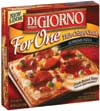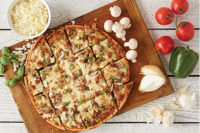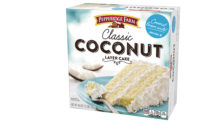
By Molly Strzelecki
There is something delectably delicious about pizza. Just the mere thought of the gooey, stretchy cheese and the thick, crispy crust can jumpstart any mouth-watering sensation.
That being said, the frozen pizza category is one of those areas in which many food manufacturers want to participate, despite the heavy competition in the freezer case. As the economy crashes into the dumps, the multi-billion dollar category is the place to be because, as most frozen pizza producers note, the market is nearly recession-proof.
In fact, a bad economy can be good news for the frozen pizza business, says Tim Cofer, president of Glenview, Ill.-based Kraft Pizza Co.
“The economy and the ongoing unsettled financial atmosphere this year has pervaded almost every aspect of consumers’ lives,” he notes. “As consumers are eating at home more these days, food retailers and frozen foods are benefiting from that change. And as it has always been, frozen pizza is a delicious, reasonably priced meal option for families and one- and two-person households to enjoy at home.”
Because of these trying economic times, Cofer adds, Kraft has been steadily building the quality focus of its DiGiorno pizza line. The company’s campaign, “It’s Not Delivery, It’s DiGiorno,” compares the taste of DiGiorno to carryout or delivery pizza.
“We aim to drive consumers into our retailers’ stores instead of to their nearby pizza chains,” he says.
Good marketing and great value may be enough to get consumers to try DiGiorno pizzas once, but the key to a hit pizza is repeat sales. Just because consumers are substituting a night in with pizza for an adventurous night out on the town doesn’t mean they’re willing to settle for a boring product.
In fact, it’s quite the opposite, Cofer notes, because consumers want the same experience they would get in a restaurant, except in the comfort of their own home. Frozen pizza manufacturers are being challenged to develop products that deliver flavorful ingredients, make for a satisfying meal and essentially recreate a pizzeria experience right from the kitchen.
Thin is Still In
Frozen pizza may stay fresh in a stale economy, but it’s crucial that producers bring a little something consumers can crave.Many of the most recent products exemplify the newest taste trend in pizza – razor-thin, crispy pizza crusts.
For example, Home Run Inn released four SKUs [stock keeping units] of its Ultra Thin frozen pizza, which has been very successful, says Joe Perrino, chief executive officer of the Woodridge, Ill.-based company.
Additionally, the Newman’s Own brand rolled out a line of Thin & Crispy pizzas, available in Supreme, Four Cheese, Roasted Garlic and Chicken and Uncured Pepperoni varieties.
“We certainly learned from our consumer work that the thin and crispy crust segment of the frozen pizza market is still growing and is still a good fit with the more wholesome positioning of Newman’s Own products,” says Mike Harvard, vice president of marketing of Newman’s Own, Westport, Conn. “Consumers love the thin and crispy style because it’s less heavy, the flavor of the toppings comes through more, it bakes up more quickly and it tends to have fewer calories versus a medium crust pizza. Our consumers really wanted us to provide our pizzas with a thin and crispy crust, and we’re glad we did.”
Other frozen pizza manufacturers such as Schwan’s Consumer Brands North America, Inc., Marshall, Minn., slice it up according to such consumer trends as convenience, great taste, health and wellness, portability and price sensitivity.
To add to the consumer demand of thinner is better, Schwan’s rolled out Freschetta PizzAmoré Fire Baked Thin Crust pizzas, Red Baron Singles French Bread Paninis and Red Baron Stone Hearth Pizza.
Single-serve options such as Tony’s Pizza for One also have been hits for Schwan’s.
“We believe we need to continue to offer a variety of innovative pizza products that address [the consumer trends impacting the frozen pizza category] while maintaining ‘excitement’ in the category,” says Dan Hammer, senior vice president of marketing for Schwan’s. “We also deliver new applications of the traditional favorites, all while giving consumers the best value in the category.”
Likewise, Kraft Foods has launched personal pizzas under the DiGiorno and California Pizza Kitchen brands.
However, while new flavor profiles and varying degrees of crispiness or “doughiness” are certainly one way to trigger hunger pangs, that doesn’t mean the traditional pizza toppings should be overlooked.
“I’ve been doing this for 36 years, and when retailers ask me what the trends are in toppings, the trends are cheese, cheese and sausage, sausage and pepperoni, pepperoni and vegetable,” Perrino says. “You can do an ultra-thin crust, you can do a deep dish, you can do a traditional crust. But those toppings are your core items that continue to sell over and over and over.”
Ode to Health
Consumer spending shows a demand in organic or all-natural products that suit newfound healthier lifestyles.For instance, Richelieu Foods, Braintree, Mass., was one of the first private label companies in the United States to offer an extensive line of organic pizzas, notes Vincent Fantegrossi, president and CEO. The company’s offerings vary in size and shape from single-serve and 12-in. pizzas to square, round and oval organic crusts. The company also offers organic cheese, vegetable and meat items.
“As a result of this product development, we have developed a sizeable portfolio of organic private label customers,” Fantegrossi says. “Looking forward, I believe there will be a slowing down of growth in this category. There is a loyal following of existing products, but most retailers feel at this time they have an adequate commitment to this category.”
All-natural products also are becoming more prevalent. For example, Perrino says that Home Run Inn offers all-natural pizzas with no preservatives and zero trans fats. And more recently, the company switched to uncured pepperoni, giving products a cleaner label.
Schwan’s also is responding to the healthy living trends with its Red Baron Thin & Crispy Singles pizzas, which contain less than 300 calories per pizza.
“Consumers’ interest in the organic and all-natural movement is impacting the category,” Hammer says, “because consumers want healthier alternatives without sacrificing great taste and convenience.”
Beyond the call for more organic and all-natural products, pizza remains relatively unaffected by consumers’ desire to eat healthy. Generally speaking, “pizza” and “healthy” are not two words used to define the category, though some pizza manufacturers would argue otherwise.
“I don’t think that pizza is going to be affected by all of the health trends,” Perrino says. “I’ll be the first one to be a proponent, not just for Home Run Inn, but for the industry as a whole, that pizza is not a junk food. Pizza offers a balanced diet. Some of the past history of pizza has shown large manufacturers using processed cheese or meats that were completely filler, but we want to resurrect pizza as a balanced diet. If we can make it healthier and better, that’s what we’re always going to push for.”
It's Not All Sunshine and Cheese
Frozen pizza producers have a lot going for them. Sales are steady and innovative new products keep the category fresh. Plus, who doesn’t like pizza?But the frozen pizza business is not always about making products topped with gooey cheese and tasty toppings.
“The volatility of commodities driven by many factors continues to impact production and pricing,” Fantegrossi notes. “This is the first time I have ever seen commodities consistently rising and falling in synch with the financial markets. The world economy and local commodities are all being affected in concert.”
Several manufacturers are implementing aggressive cost-saving measures, he continues, while refraining from passing on the increased costs to the consumer, which could spark the sales of private label products.
“We have experienced a significant surge in private label products in the past six months,” Fantegrossi adds. “There is no question that the current economic climate has driven the consumer to value. The good news is that once a consumer tries private label products, they realize that private label offerings are as good or better than national brands at a much lower cost.”
Rising Dough
While other food categories may fret over how to grow in uncertain economic times, frozen pizza manufacturers are confident that their product sales have nowhere to go but up.“We continue to see growth across the frozen pizza category given its inherent value versus carryout or delivery,” Cofer says. “And, we also see consumers continuing to enjoy the convenience and premium quality of frozen pizza offerings. As a category, frozen pizza is definitely on a growth trajectory.”
Furthermore, an ongoing challenge, Harvard says, involves how to continue to grow the category. “By delivering innovation in the premium segment with all-natural products, Newman’s Own can help retailers address the growth challenge,” he says.
The frozen pizza business also enjoys the benefit of constant innovation and improvement, Fantegrossi says.
“In these economic times, frozen pizzas offer an incredible value to the consumer,” he notes. “More and more families are enjoying a pizza for dinner in place of going out for dinner.”
Whether eating alone or sharing with others, economical woes won’t turn this category upside down. Rather consumers just need more hours in the day to relax at home and slice up a bit of a thin-crust pie.


